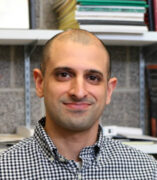
Neal Mankad
Professor and Associate Head
Contact
Address:
4242 SES, MC 111
Office Phone:
Email:
Related Sites:
About
Research in the Mankad group focuses on understanding multimetallic cooperativity in catalysis. We approach this through two parallel approaches. First, we invent new bimetallic complexes designed to catalyze transformations of importance to organic synthesis as well as small-molecule conversions of relevance to energy storage and environmental remediation. In some cases, the bimetallic cooperativity inherent to these bimetallic complexes has allowed us to use earth-abundant metals for catalytic transformations typically associated with single-site precious metal systems. In other cases, completely novel reactivity has emerged through careful study of the cooperative effect. Secondly, we construct synthetic complexes that model the active sites of metalloproteins that feature bioinorganic clusters thought to utilize multimetallic cooperativity in nature. The goal is to understand how nature has evolved to use multimetallic cooperativity to mediate multielectron redox transformations, and to apply those lessons to the design of new synthetic catalysts. Students and postdoctoral researchers use techniques for air-free chemical manipulation, and methods of analysis in use include multinuclear NMR spectroscopy, IR spectroscopy, single-crystal X-ray crystallography, mass spectrometry, cyclic voltammetry, and quantum chemical calculations. For more information, please visit our group webpage.
Selected Publications
1. Cheng, L.-J.; Mankad, N. P. “Heterobimetallic Control of Regioselectivity in Alkyne Hydrostannylation: Divergent Syntheses of α- and (E)-β-Vinylstannanes via Cooperative Sn-H Bond Activation.” J. Am. Chem. Soc. 2019, 141, 3710-3716.
2. Bagherzadeh, S.; Mankad, N. P. “Oxidation of a [Cu2S] Complex by N2O and CO2: Insights into a Role of Tetranuclearity in the CuZ Site of Nitrous Oxide Reductase.” Chem. Commun. 2018, 54, 1097-1100.
3. Pye, D. R.; Cheng, L.-J.; Mankad, N. P. “Cu/Mn Bimetallic Catalysis Enables Carbonylative Suzuki-Miyaura Coupling with Unactivated Alkyl Electrophiles.” Chem. Sci. 2017, 8, 4750-4755.
4. Johnson, B. J.; Antholine, W. E.; Lindeman, S. V.; Graham, M. J.; Mankad, N. P. “A One-Hole Cu4S Cluster with N2O Reductase Activity: A Structural and Functional Model for CuZ*.” J. Am. Chem. Soc. 2016, 138, 13107-13110.
Education
S.B., Massachusetts Institute of Technology (Advisor: Joseph Sadighi), 2000-2004.
Ph.D., California Institute of Technology (Advisor: Jonas Peters), 2004-2009.
NIH Ruth L. Kirschstein NRSA Postdoctoral Fellow, University of California at Berkeley (Advisor: Dean Toste), 2010-2012.